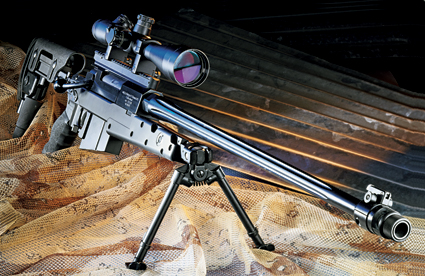The folding buttstock is adjustable for length of pull, cheekpiece height and buttpad height. It has an integral monopod and handstop along with two flushcup sling points.
Well, no one will mistake that for a hunting rifle,” I thought, as I took my first look at the Brugger & Thomet’s APR338 .338 Lapua Mag. This gun was conceived and built from the ground up specifically for long-range sniping applications. Matte black, steel and aluminum, without any smooth curves or fancy engraving—it’s all business.
The action is a single rectangular block of steel measuring 9.5x2x1.75 inches. A 9.5-inch Mil-Std-1913 rail is bolted to the receiver with six screws. The rail has 40-MOA of slope built in to extract the maximum possible elevation travel from the standard Schmidt & Bender optic. The rail also sports a flip-up aperture rear emergency backup sight, though I can’t imagine it will ever get much use on this type of rifle. A fully protected bolt stop/release is attached to the left rear with a solid steel pin. The bolt is a three-lug, 60-degree, short throw type. One full inch in diameter with various lightening cuts, the construction seems unique. The bolt head is attached to the bolt body via two large diameter roll pins. The head itself is of conventional design with a plunger ejector and spring-loaded snap over extractor in the top right lug. A long groove a little over 0.25 of an inch wide provides the bolt stop surface as well as the anti-bind rail. This prevents marring of the bolt lug by the bolt stop. An interesting rearward curving bolt handle with a non-metallic ball end is fixed to the rear of the bolt body. The curve places the ball directly above the trigger, making fast bolt work a simple affair. A special tool is provided to take down the firing pin system.
Advertisement — Continue Reading Below
 Folding to the left side, the stock latches in both positions via a button seen here above the base of the monopod.
Folding to the left side, the stock latches in both positions via a button seen here above the base of the monopod.
Barrel Details
The 27-inch fluted barrel is screwed into the receiver in the conventional manner, but in addition to the flutes there are wrench flats cut into the shank at the receiver junction, which permit a simple vise/wrench combo to remove and replace barrels rather than a special barrel vise. This is unique in my experience, and should make field re-barreling work a little simpler.
 The muzzle brake has a threaded
The muzzle brake has a threaded
section protected by a knurled cap. The suppressor screws on over the brake and seals against a tapered surface, while a folding front sight is built into the brake.
Advertisement — Continue Reading Below
Twist rate is 1-in-11 inches, which will be only just adequate to stabilize 300-grain projectiles. It is of a fairly light Palma-type profile, 0.75 of an inch in diameter at the muzzle and 1.5 inches at the breech. The business end of the barrel is equipped with a large two-vent muzzle brake, which is threaded and has a knurled thread protector permitting attachment of a sound suppressor that goes over the brake vents and seals against a tapered surface. A flip-up front sight is attached, completing the emergency sight system. The sight base and Mil-Std-1913 rail have small transverse holes that are used to attach the supplied mirage band. Commonplace in competition rifles, I’ve rarely seen one used in the field, though it can prove useful during training sessions, where a number of shots will cause enough barrel heat to distort the sight picture.
























